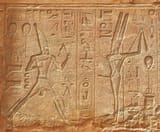Search Results
7/20/2025, 1:28:42 AM
>>40758897
>The worship of Min was universal throughout Egyptian history; but two cities were particularly associated with him: Gebtu and Khent-Min. Gebtu (called Koptos by the Greeks; now known as Qift) lies on the east bank of the Nile some 40 km north of Luxor, at the terminus of the route which leads from the Red Sea to the Nile. It achieved great importance at an early date because of its geographical position: mining expeditions to the Eastern Desert and trading expeditions to the Red Sea had their starting point at Gebtu, which therefore became the obvious choice to become capital of the 5th Nome of Upper Egypt. The original god of Gebtu seems to have been a phallic deity named Rahes or Aahes, who appears in the Pyramid Texts as ‘Regent of the Land of the South’. Rahes and Min, depicted as falcons, formed the nome standard, although later on, when Horus and Isis became popular in Gebtu, the two falcons of the nome standard were identified with Horus and Min.
>Min of Gebtu (Min of Koptos) was considered to be the tutelary deity of nomads, hunters, miners and travellers, for the Eastern Desert was his special domain. As a deity of the desert, Min was associated with the thunder that was thought to emanate therefrom. Thus, when the Canaanite-Phoenician god of thunder and war, Reshep, was introduced into Egypt during the New Kingdom, it was natural that he should be allied with Min. They were both given the Syrian goddess of love, Kadesh, as partner, with the three deities combining to form a triad of fertility, thunder and love!
>The worship of Min was universal throughout Egyptian history; but two cities were particularly associated with him: Gebtu and Khent-Min. Gebtu (called Koptos by the Greeks; now known as Qift) lies on the east bank of the Nile some 40 km north of Luxor, at the terminus of the route which leads from the Red Sea to the Nile. It achieved great importance at an early date because of its geographical position: mining expeditions to the Eastern Desert and trading expeditions to the Red Sea had their starting point at Gebtu, which therefore became the obvious choice to become capital of the 5th Nome of Upper Egypt. The original god of Gebtu seems to have been a phallic deity named Rahes or Aahes, who appears in the Pyramid Texts as ‘Regent of the Land of the South’. Rahes and Min, depicted as falcons, formed the nome standard, although later on, when Horus and Isis became popular in Gebtu, the two falcons of the nome standard were identified with Horus and Min.
>Min of Gebtu (Min of Koptos) was considered to be the tutelary deity of nomads, hunters, miners and travellers, for the Eastern Desert was his special domain. As a deity of the desert, Min was associated with the thunder that was thought to emanate therefrom. Thus, when the Canaanite-Phoenician god of thunder and war, Reshep, was introduced into Egypt during the New Kingdom, it was natural that he should be allied with Min. They were both given the Syrian goddess of love, Kadesh, as partner, with the three deities combining to form a triad of fertility, thunder and love!
Page 1
